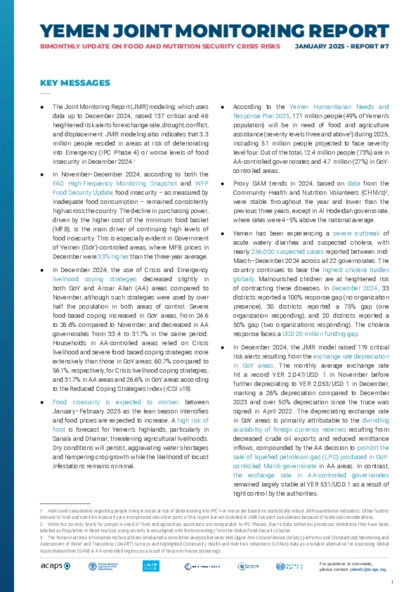Latest updates on country situation
05 November 2024
Prolonged conflict, political instability, and economic disruptions have led the Yemeni rial to depreciate sharply. In November 2024, in areas under the Internationally Recognized Government of Yemen, the exchange rate hit a record low of less than YER 2,100 per USD 1. This depreciation has led to soaring prices for essential goods, such as rice, wheat, and fuel. This is severely straining Yemeni households’ ability to afford basic food items as inflation continues to erode purchasing power. (Yemen Future 05/11/2024, FAO 31/10/2024, Xinhua 16/10/2024)
27 September 2024
On 26 September 2024, Houthi forces targeted Yemeni civilians celebrating the 1962 Revolution, affecting over 428 people across ten governorates. Violations included 235 cases of arbitrary detention and disappearances, 97 physical assaults, 52 home raids, and 44 verbal assaults. Ibb recorded the highest number of incidents, followed by Al Hodeidah, Dhamar, and Sana’a. (Rights Radar 27/09/2024, Al Masdar 26/09/2024)
03 September 2024
On 30 August 2024, heavy rains caused a dam to overflow in Bani Musa, leading to floods that have swept away buildings and residents in Al Jarf village, Wusab As Safil, Dahmar governorate. This event has resulted in 27 deaths, eight injuries, and three people missing, along with the destruction of 28 homes, four cars, and shops, as well as the loss of agricultural crops. Throughout August, heavy rains and widespread flooding affected 424,123 people across Yemen. (YF 02/09/2024, IFRC 02/09/2024)
19 August 2024
By the end of 2024, approximately 609,800 children in areas under the control of the Internationally Recognized Government of Yemen will be acutely malnourished, with close to 118,600 severely affected – a 34% increase from 2023. Acute malnutrition is particularly critical in Al Hodeidah and Ta’iz, with two districts in Al Hodeidah and one in Ta’iz currently facing Extremely Critical (IPC AMN Phase 5) conditions. Major contributing factors include inadequate diet diversity, poor breastfeeding practices, high disease prevalence, and limited access to food, WASH, and health services. (IPC 19/08/2024, UNICEF 18/08/2024)
12 August 2024
Yemen is facing a worsening humanitarian crisis, severely aggravated by heavy rains and floods since March 2024 and even more destructive rainfall from late June to early August. The floods have affected several governorates, including Al Hodeidah, Al Mahwit, Hajjah, Sa’dah, and Ta’iz, severely affecting infrastructure, agriculture, and health facilities and killing 57 people, injuring 16, and displacing over 3,600. Al Hodeidah alone has seen significant damage in 20 districts, affecting 36,126 people (5,392 families) and leading to the loss and destruction of 440 legal documents, 200 livestock, 21 water schemes, eight roads, two local markets, and some school facilities. In Abs district, Hajjah, 2,800 people (418 families) have been affected. Bani Sa'd district, Al Mahwit, has also suffered severe infrastructure damage, isolating many communities. In Maqbanah, Ta’iz governorate, floods on 3 August affected nine subdistricts and 19 villages, directly affecting 1,184 people (191 families). (UNFPA 08/08/2024, UNHCR 12/08/2024, OCHA 11/08/2024)
04 August 2024
On 23 July 2024, floods from torrential rains washed away hundreds of homes in Sa’dah governorate, affecting 2,000 families and damaging over 1,000 shelters in IDP sites. Three people including a child died. Floodwaters reached depths of 30–40 cm, worsening the suffering of IDPs and affecting access to clean water and sanitation. Since early 2024, rising violence and severe weather have displaced over 75,000 people in Yemen, leading to increased hunger and malnutrition. (UNFPA 02/08/2024, OCHA 28/07/2024, UNICEF 22/07/2024)
23 July 2024
Mwatana for Human Rights reported that Israeli airstrikes on Hodeidah and Saleef ports, and power stations in Hodeidah, Yemen, killed nine workers, injured over eighty, and displaced numerous families. The strikes targeted vital civilian infrastructure crucial for delivering over 80% of Yemen’s humanitarian aid, threatening the survival of millions.
current crises
in
Yemen
These crises have been identified through the INFORM Severity Index, a tool for measuring and comparing the severity of humanitarian crises globally.
YEM001 - Complex crisis
Last updated 28/03/2025
Drivers
Conflict
Displacement
Crisis level
Country
Severity level
4.5 Very High
Access constraints
5.0
YEM002 - Mixed Migration
Last updated 28/03/2025
Drivers
Displacement
Crisis level
Country
Severity level
2.3 Medium
Access constraints
3.0
Analysis products
on
Yemen
02 April 2025
Bimonthly update on food and nutrition security crisis risks- Issue 8
DOCUMENT / PDF / 2 MB
The JMR combines quantitative modeling and qualitative analysis to provide robust bimonthly food and nutrition security monitoring that identifies emerging food and nutrition security crisis risks.
31 January 2025
Yemen: bimonthly update on food and nutrition security crisis risks issue 7
DOCUMENT / PDF / 2 MB
The report aims to complement IPC analyses and facilitate early recognition and coordinated responses to emerging major food and nutrition security crises among humanitarian and development stakeholders.
23 January 2025
Yemen: access to reproductive health for women and girls
DOCUMENT / PDF / 275 KB
This report explores the availability of SRH services in Yemen and the multidimensional challenges faced by women and girls in accessing available services, highlighting the intersection of cultural, economic, and structural barriers.
Attached resources
29 November 2024
Yemen: Bimonthly update on food and nutrition security risks - issue 6
DOCUMENT / PDF / 2 MB
This report aims to complement IPC analyses and facilitate early recognition and coordinated responses to emerging major food and nutrition security crises among humanitarian and development stakeholders. The JMR is the product of a core development team comprising members from ACAPS, FAO, UNICEF, WFP, WHO, and the World Bank
30 September 2024
Yemen: Bimonthly update on food and nutrition security risks - issue 5
DOCUMENT / PDF / 3 MB
This report aims to complement IPC analyses and facilitate early recognition and coordinated responses to emerging major food and nutrition security crises among humanitarian and development stakeholders.
Related datasets
Discover the
Yemen Economic Tracking Initiative
Economic trends and developments to support analysis and economic policy for Yemen
https://yemen.yeti.acaps.org/






